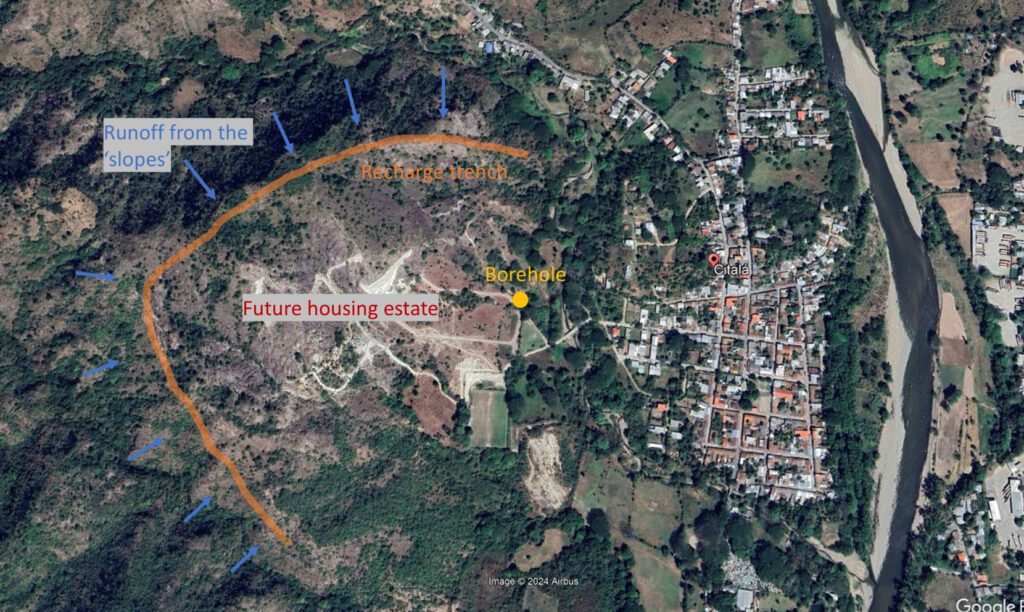The water security principles for most rural catchments are straightforward: catch rainfall, slow down runoff, and store as much water as possible in the ground or other storage facilities. Equally well-known—and proven—are the techniques to perform these tasks: swales, recharge areas and galleries, permanent groundcover, check dams, leaky weirs, small reservoirs, etc.
The problem, however, is to get this done at scale. Available budgets of government agencies are invariably inadequate.
This is where permits come in. The permit that regulates water abstraction is often the only instrument at the disposal of a water agency to directly influence the behavior of actors in a catchment. Unfortunately, and quite surprisingly, this tool is barely used.
A case in point is the below example.
A housing estate is being developed near the small town of Citala in El Salvador. The development comprises some 40 houses. Water supply is provided by a well on the estate. A permit to establish the borehole was requested and received. But the water agency asked for nothing in return apart from a small fee. And in my view, that is a missed opportunity. Specifically, the agency could have asked for recharge infrastructure—which is extremely cheap to build in the construction phase of a housing estate, when heavy machinery is present on site and when substantial parts of the project area, specifically near the edges, are still without a permanent function.

The estate is being built on a flat alluvial area—with a surface area of some 0.3 km square—surrounded on three sites by mountainous terrain with rather steep slopes. During intense rain events, the runoff coefficient on these slopes will be high and the mountain crescent will produce significant runoff. Hence drainage infrastructure is likely needed to prevent this water from damaging properties and roads on the estate.

However, if a recharge trench (or something similar) was built along a part or the entire crescent—for instance 1.5 m deep and 2 m wide, filled with rocks and gravel, at the point where the ‘slope meets the plain’—most of this water would be captured and gradually infiltrate into the shallow aquifer. Over time, this water would reach the well since the borehole is located at the downstream end of the plain. Similarly, each house could be required to install roof water harvesting facilities in combination with a shallow recharge well—all very cheap in the construction phase of a project. These combined water harvesting elements would ensure a steady recharge of the aquifer on which the estate, in fact, depends for its water supply, and thus enhance overall water security. In addition, it would mitigate flooding and associated flood damage and thus climate proof the area. It’s a beneficial setup.
A two-way permit that would request large landowners—such as a housing estate—to establish water security infrastructure as a condition to abstract water, is an effective strategy to implement water security measures at scale. I think the ‘reciprocal’ permit represents an opportunity that we should no longer ignore. Moreover, it seems entire fair to ask those who abstract water to do something in return to ensure the long-term availability of this precious resource.
Intuitive design based on field observations
“Uncertainty abounds about what happens under the ground”
Field observations during an intense rain event are the starting point of a water harvesting design. It will reveal the extent of overland flow and runoff in rivulets, gullies, and streams, and therefore disclose where interventions are required. Given the small scale of the estate, there is no need for a detailed design that involves groundwater modeling.
The beneficial functions are clear: groundwater recharge, flood mitigation, enhanced climate resilience, and secure water supply. These ‘no-regret’ functions are non-contradictory and do not involve trade-offs. Besides, there is simply not enough information about this small aquifer to accurately predict the groundwater flows. What we know is that the extra recharge will at some point in time reach the well—be it in 1 year of 5—and therefore increase the long-term sustainable water abstraction rate.
Management System
To reduce the ad-hoc nature of decision making regarding these small-scale interventions, some level of management process would be useful. Would the below heuristic be practical for these one-off investments that should remain functional for decades or longer?

Andrew Millison has prepared an insightful & enjoyable video on small-scale groundwater recharge in urban areas in India:
